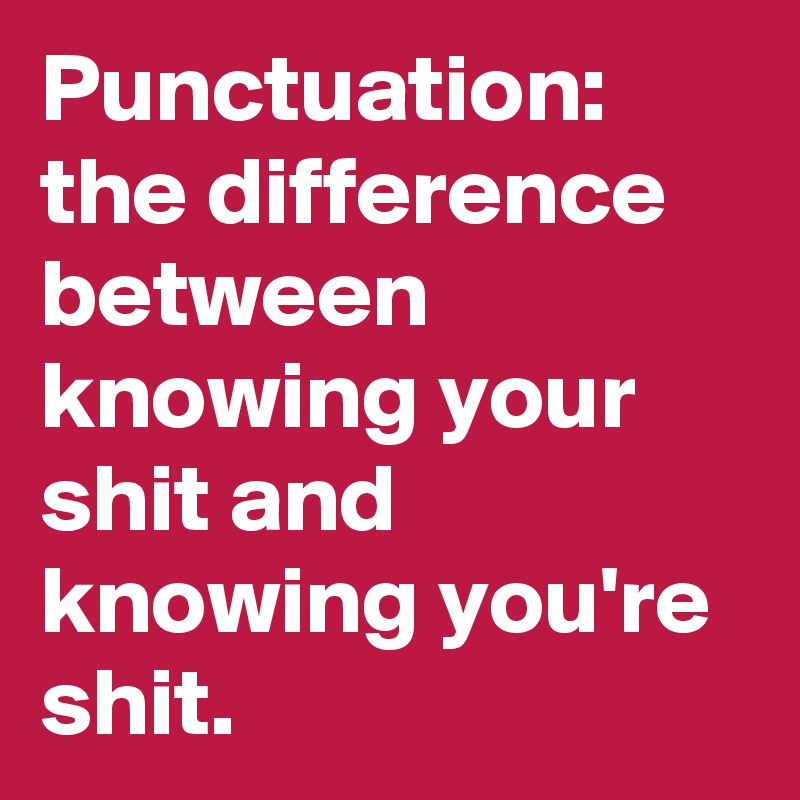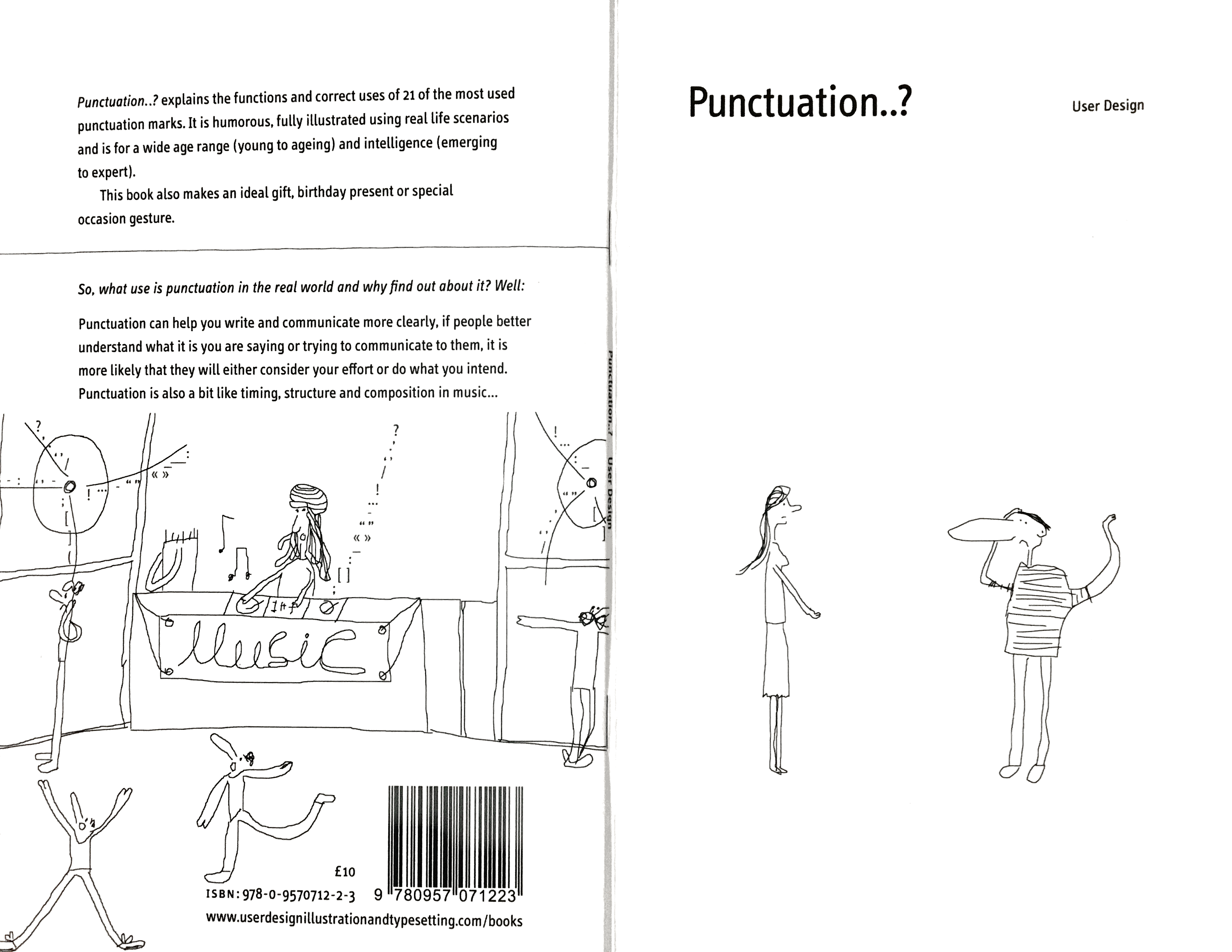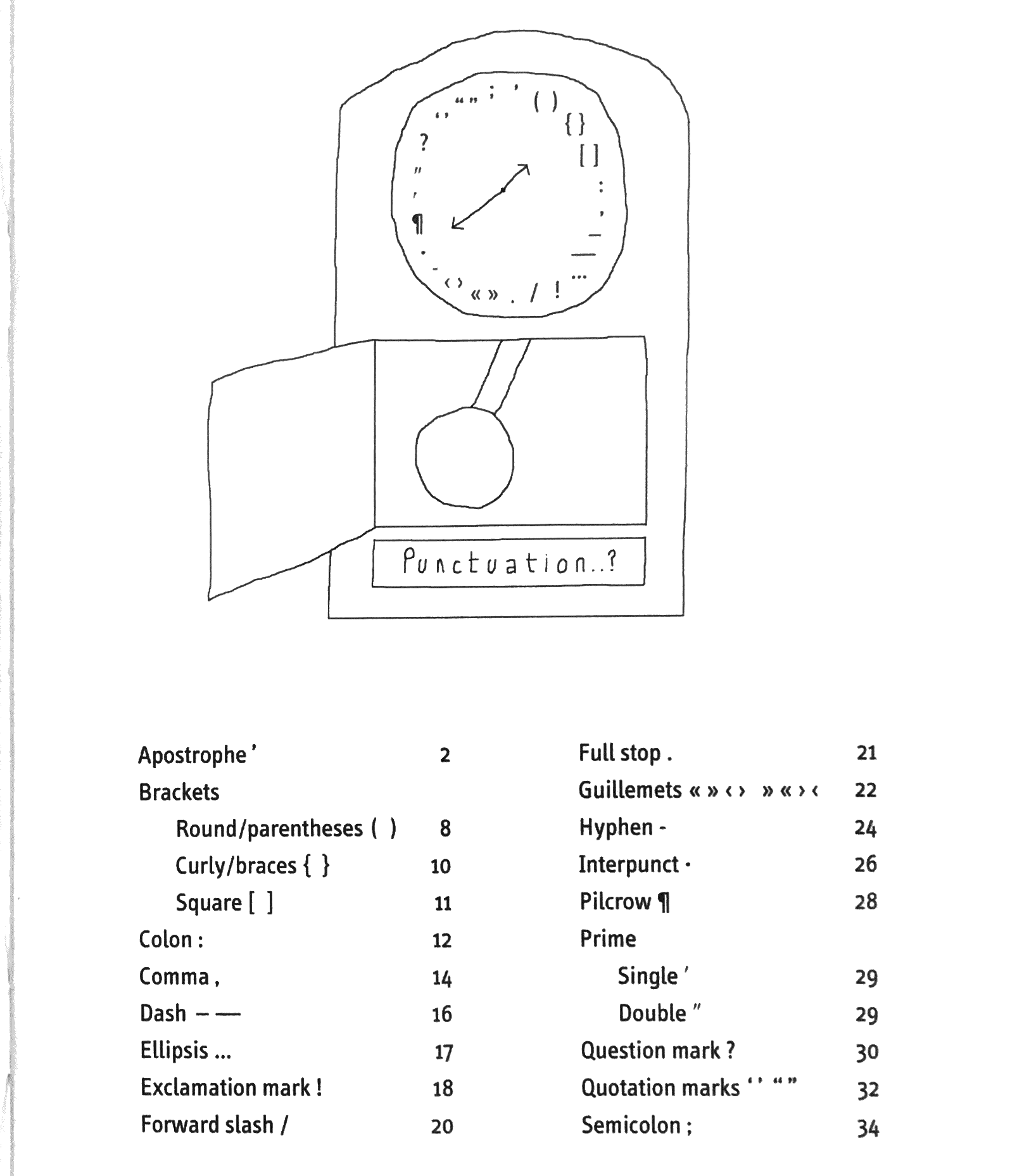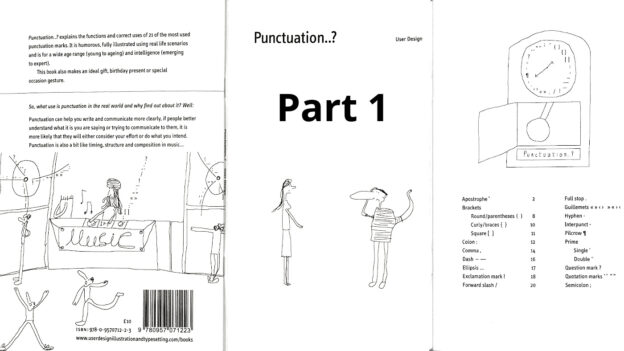This episode is about the importance of punctuation in writing. I’ll teach you the names of various punctuation symbols and review a cool punctuation reference book that someone sent me recently, and yes I do think it is possible to have a cool book about punctuation! Transcript available.
![]() [DOWNLOAD] [CAMBLY OFFER]
[DOWNLOAD] [CAMBLY OFFER]
Introduction
In this episode I’m going to talk about… punctuation!
I’m going to talk about punctuation, teach you the names of most of the main punctuation symbols we use when writing. I’m going to explain the rules/uses of some bits of punctuation (namely the apostrophe, comma and full stop) and also I’ll be doing a review of a book about punctuation that you might be interested in purchasing.
So this is an episode of an audio podcast about punctuation which is a completely visual system, so this might be a bit ambitious and there will be times when I’m trying to describe punctuation symbols, so I expect there will be some bits of descriptive language there to look out for, as well as just loads of commentary and also a book review from me.
What is punctuation?
Just in case you don’t know, punctuation means all the symbols we use to perform various functions when writing. This means things like full stops, commas, apostrophes and things like that.
I don’t often talk about writing on this podcast. The focus is usually on speaking, listening, vocabulary, bits of grammar, pronunciation and of course just talking about various topics in order to help expose you to loads of English through audio, like I talked about in the last episode about the importance of listening in your learning of English.
Writing can be difficult to teach in an audio podcast, and that’s one of the reasons I don’t talk about it that much. But I’d like to deal with it sometimes if it’s possible and punctuation is actually one of those areas of writing that often doesn’t get taught, but it’s a really important part of writing.
First of all, it’s something that a lot of learners of English need to work on. In my experience as a teacher, I’ve seen plenty of issues relating to it in my students’ work. This includes basic things, like just not putting full stops at the end of sentences, or getting confused about the difference between a plural S and a possessive S. So there are certain basic errors that you really should avoid.
Also, learning about punctuation can really help your grammar. The more you understand punctuation, the more you understand the way sentences are constructed and the more you are able to then get control over those things.
Basically – learning about punctuation helps you to write better and that is just one of the things you have to deal with if you would like to get a proper grip on this language.
Also, there’s that famous quote which illustrates perfectly the importance of punctuation, “Punctuation is the difference between knowing your shit and knowing you’re shit.”

Source: Boldmatic.com https://boldomatic.com/p/2FfrVQ/punctuation-the-difference-between-knowing-your-shit-and-knowing-you-re-shit
Is punctuation always important?
I would say that punctuation is always important if you want to be clear and correct, which I assume you want to be. Who would want to be vague and wrong? Nobody, I think!
Does punctuation change depending on the situation or the type of writing we’re doing?
Obviously, the more formal your writing the more important it becomes. If you’re writing external business correspondence, legal contracts, letters of application to university, academic essays and so on, then punctuation is going to be a big consideration for you, because you have to pay very close attention to the clarity of your writing.
But what about informal writing?
Some people might say that you don’t need to worry about punctuation in things like emails to your friends or work colleagues that you know well, or in text messages and comments online and stuff. Arguably there is a different set of conventions for those things, but I still think punctuation is really important even in informal writing like that.
Perhaps some of the rules are a bit different when doing informal writing. For example, I think it’s normal, when having a text chat with a friend, not to put full stops at the end of your sentences. In fact, I think the way we use full stops in text messages has changed recently. I mean, if you’re having a chat, you might leave the full stops out of your final sentences as a way of showing that the conversation is still open. For me, a full stop at the end suggests “that’s it”, which can suggest “this chat is over”. That’s a subtle thing, but I think it’s true.
Article: The Text Message You Should Never Send, by Rachel Feltman
OK, I’m going off on a bit of a tangent here, but here’s an article I just found from The Independent, which I think is interesting. This article is called The Text Message You Should Never Send, written by Rachel Feltman (published in December 2015)
Basically it’s talking about how putting full stops at the end of sentences in text messages looks unfriendly and insincere and that this is backed up by research from Birmingham University.
OK, let’s have a bit of a read and then get back to the point.
https://www.independent.co.uk/life-style/gadgets-and-tech/news/never-end-your-text-messages-with-a-full-stop-a6766011.html
Basically, punctuation is important. Knowing when or when not to use it is an important skill to master.
If you’re serious about improving your written English, you’ve got to get punctuation right. It makes a huge difference to the impression you give to people reading your emails, essays, reports or whatever it is you’re writing, even your text messages or website comments. It’s all about getting more control over your communication, which is what it’s all about, isn’t it?
Think of punctuation being to writing what pronunciation and body language are to speaking.
When we speak we use lots of different ways to add interpretation to our words. We use stress and intonation to give emphasis and tone and we use our faces and hands too. At this point my Italian listeners are saying “Yes Luke, we know all about that.”
So, punctuation is something that is absolutely crucial for your writing.
Let’s get back on track here.
Do you know the words for all the punctuation symbols in English? Do you know how to use them properly?
The plan in this episode, like I said at the start, is to teach you the words for some punctuation marks and symbols we use when writing, explain the rules/uses of these bits of punctuation and also I’ll be doing a review of a book about punctuation that you might be interested in purchasing.
About the book I just mentioned. Let me say a few things about it before we start. You’re now going to hear me describing this book. Watch out for the language I’m using. You can read a lot of this on the transcript for this episode which is available FREE on my website! So, if you hear me using certain words or phrases that you didn’t catch, head to teacherluke.co.uk and find the page for this episode. The script is there for you to read or just skim for vocabulary.
Book: Punctuation..? By User Design
A while ago I was contacted by a listener to this podcast who is an author, illustrator, designer and publisher – yes, all at the same time apparently! He’s published a book about punctuation in English and he offered to send me a copy of the book in return for a little review of it on the podcast. I thought it could be a good opportunity to talk about punctuation, to teach my listeners some of the words for punctuation marks and to give some comments about punctuation rules, so I accepted to do the review. It’s a good deal for everyone – you can hear me talk about punctuation and perhaps learn some things, I get a copy of the book and the author gets a bit of publicity.
The book is called “Punctuation…?” and the author goes by the name User Design, which is actually a service/business name that he’s using. So, let’s call him Mr User Design.
Actually the full name of this guy’s company is “User Design, Illustration and Typesetting”. A quick look on their website shows that they provide various services, and I quote, “We offer a complete graphic communication design, illustration and production service, from books to websites, to many other printed and electronic items.”
You can check out their website at https://www.userdesignillustrationandtypesetting.com/ It’s a nice-looking website. Mr Design clearly has an eye for a functional design aesthetic.
So, one of their products is this handy guide for punctuation. It’s a pretty slim book with a clear contents page where you can see all the main punctuation marks that you should know about, with page numbers as you’d expect. It’s all very minimal and clear. But this isn’t just a boring reference book. One of the first things you notice when you open it is that it contains lots of cartoon illustrations to keep things interesting and fun.
They say you shouldn’t judge a book by its cover. This is a famous saying, which means that you shouldn’t judge a person by their appearance. But in the case of books, I have no idea how you are supposed to judge a book before you have read it. Judging it by its cover is pretty much the only thing you can do, isn’t it! I suppose you can flick through it and maybe read the first few pages, but if you’re standing there in a bookshop reading a book, the person behind the counter might start to get a bit peeved after a while.
Anyway, let’s judge this book by its cover. The front cover is very minimal. It’s black and white. There’s the title, “Punctuation…?”, the author (User Design) and then a cartoon illustration of two people apparently communicating with each other. The one on the left is a girl holding her hand out as if she’s saying something and the one on the right is a guy scratching his head with his other hand in the air, and it looks like he’s confused.

Punctuation..? by User Design (front and back covers)
The illustrations are simple sketches done with a pen. They’re quirky. Thin lines. They look a bit like doodles but they’re quite funny. There isn’t anything else. Now, I reckon most people would not really know what to make of that. Well, maybe there would be two reactions – one would be “oh this looks quirky and cool – a hip book about punctuation” and some others might think “This doesn’t look serious enough and I don’t know why these people are standing there like that – what does that have to do with punctuation?” That’s just the front cover though.
If you look inside and actually read all the pages, it’s clear that this is a clear and simple guide to what the different punctuation symbols are and how they are used. But I reckon most people would expect something a bit more academic, like your average dictionary or reference book.
On the back cover you’ve got some text explaining the book, as usual, and another cartoon illustration.
I’ll read the text to you.
Luke reads the back cover of the book. See the pic above ⤴️⤴️⤴️
OK, great. That’s nice and clear.
The illustration shows some kind of nightclub or party with a dreadlocked DJ spinning records on his decks and funny-looking people dancing. You can see (but you have to look pretty carefully – it’s not obvious at first glance) punctuation symbols coming out of the speakers and sort of flying out of the turntables where the DJ is spinning what I assume is some kind of awesome bass-heavy dancehall reggae or maybe drum and bass. It’s cool – and a different way to do a book about punctuation, but I reckon some people won’t really get it.
In my experience, people expect a more serious and academic feel from this kind of thing. I remember once we had a publisher visit The London School of English to get feedback on some new dictionary designs. He had dictionaries from different publishers and asked us which ones we liked and which ones we thought learners of English would like.
We all liked the fresh-looking, minimal, modern-looking dictionaries, but he told us that the most popular ones with learners of English were the ones with slightly old-fashioned designs, older looking fonts (I mean classical-looking fonts – I don’t know all the correct words for fonts – I think serif fonts probably). Basically, learners felt like they trusted dictionaries that looked older, more formal, more established, more old-fashioned, with words like Oxford and perhaps even symbols featuring old buildings and things on them. Also, darker colours were more popular. That’s all probably because those designs made the dictionaries look more serious and full of trustworthy information published by well-established institutions.
So, this book might not give the right impression, but on the whole I think the content is mostly good and it certainly can tell you what you need to know about punctuation.
OK, let’s have a look at the contents page of the book. Some of you at this point will be craving a video for this. Maybe I’ll record one, just to show you the front and back, but it depends if I have time! We’ll see. I think you can just use your imagination though and just follow what I’m saying.
By the way, User Design have given me permission to use some images of the book from their website, so I’ll probably add some of those to the page for this episode on my website, so have a look there to get an idea of the way the book looks and the illustrations I’m talking about.
Right, so the contents page. Here are the things the book covers.
Luke reads out the contents page and describes the different punctuation symbols and gives their names. See pic below for the symbols ⤵️⤵️⤵️

Contents page from Punctuation..? by User Design
OK, we’re going to stop the pod here. This episode will continue in part 2 which should be uploaded very soon and might in fact be available for you now.
In part 2 I’m going to talk about some punctuation rules, focusing on 3 very common bits of punctuation – apostrophes, full stops and commas. I’ll talk about how these symbols are used in writing. I’ll point out some common errors and how to avoid them and I’ll finish my review of the punctuation book I’ve been talking about.
Remember, on the page for this episode on my website you’ll find a pretty much full script for this episode … as well as pictures of the punctuation book and links for information if you’re interested in buying it.
OK! Nothing more to add here then except the usual suggestions that you become a premium LEPster to gain access to the ever-growing library of episodes devoted to language teaching. Go to www.teacherluke.co.uk/premium for that.
Also, you could consider checking out today’s sponsor, Cambly in order to find teachers for that all-important speaking practice. Go to www.teacherluke.co.uk/cambly to check it out and use my ambassador code teacherluke to get those 10 free minutes of conversation.
Thanks for listening and supporting this podcast over the years. I received loads of nice messages for the 10th birthday of LEP. I’m very glad to have such a cool audience from around the world. Speak to you again in part 2!
But for now, bye bye bye bye bye!
Luke
LINKS
User Design Website https://www.userdesignillustrationandtypesetting.com
Their books https://www.userdesignillustrationandtypesetting.com/books
The page for Punctuation…? Includes all the relevant information, including how to get the book https://www.userdesignillustrationandtypesetting.com/books/punctuation/index.html
